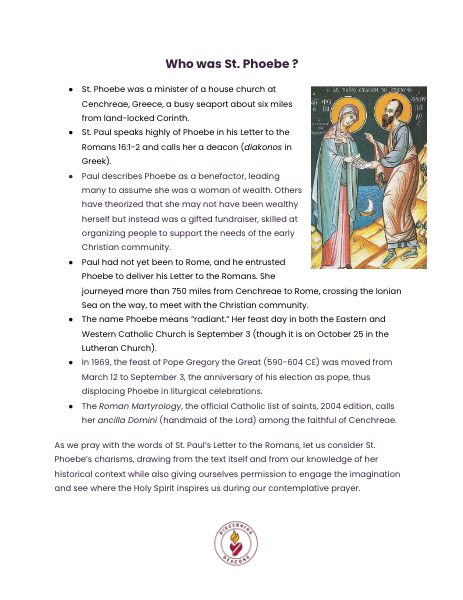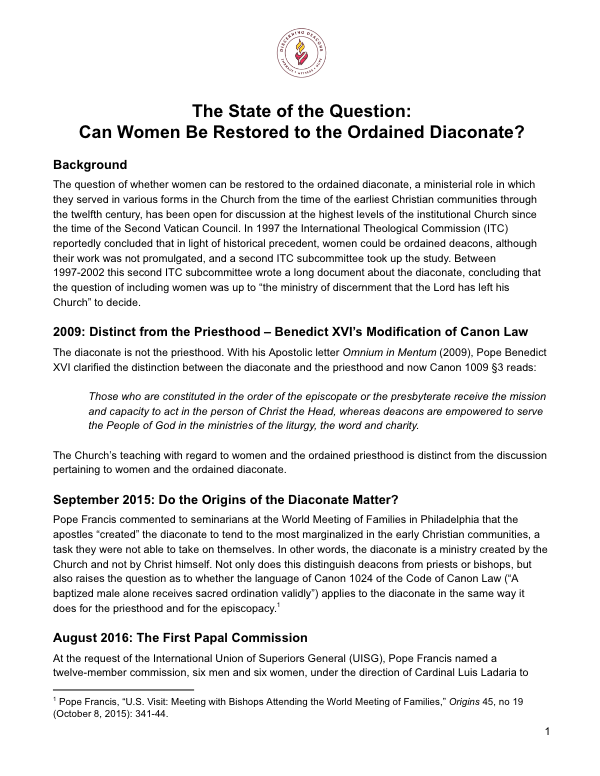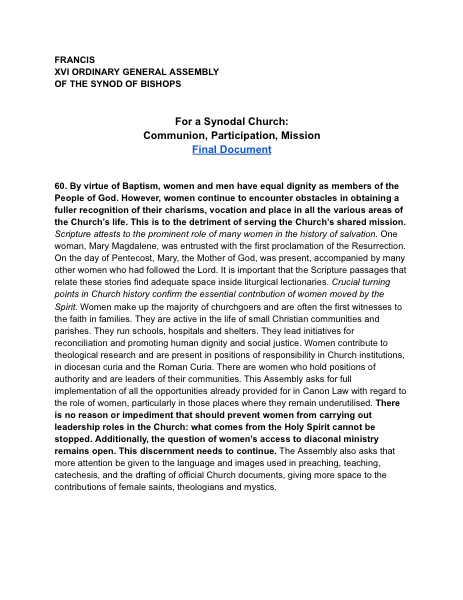Learn
“This tradition which comes from the Apostles develops in the Church with the help of the Holy Spirit. For there is a growth in the understanding of the realities and the words which have been handed down. This happens through the contemplation and study made by believers, who treasure these things in their hearts through a penetrating understanding of the spiritual realities which they experience.”
– Second Vatican Council, Dei verbum, 8.
Dr. Phyllis Zagano writes for Commonweal (July 23, 2023) tracing the themes that have been emerging through the synodal process of listening consultations and communal discernment. A well-researched overview of what various reports from around the world had to say on the question of women’s roles and possible inclusion in the ordained diaconate.
Australian theologian Margaret Mowczko wrote this chapter for the book Deacons and Diakonia in Early Christianity: The First Two Centuries published by Mohr Siebeck (January 2019). She uses biblical and historical scholarship to unpack the meaning of St. Paul’s affirmation of Phoebe as “our sister,” “a benefactor of many,” and his use of the Greek word Διάκονος (deacon) to describe Phoebe’s ministry at Cenchrea.
Ad Hoc Committee of the Canon Law Society of America, Canonical Implications of Ordaining Women to the Permanent Diaconate. Washington, DC: Canon Law Society of America, 1995. (Electronic and/or PDF versions of The Canonical Implication of Ordaining Women to the Permanent Diaconate ©1995, the Canon Law Society of America. All rights reserved. Used with permission.)
Who was St. Phoebe? And was she really a deacon?
Befriending Phoebe, a Co-Worker in the Kingdom – Sr. Colleen Gibson writes for the Global Sisters Report, inviting readers to befriend this otherwise lesser known saint, a collaborator with St. Paul, whose memory has always inspired the Church when it comes to the question of women’s fitfulness for embodying Jesus’s diakonia.
Fr. Felix Just, SJ, who teaches in the Diaconate Formation programs of several U.S. dioceses, and maintains a large internationally-acclaimed website of “Catholic Resources”, addresses the question head on – “Is St. Phoebe a Saint?” in an article for LaCroix International and an expanded version with footnotes on his website.
DD in the News
All Things Considered (NPR, June 10, 2025)
Casey Stanton on the "Preach" Podcast (America Media, April 21, 2025)
By Ellie Hidalgo (US Catholic, March 25, 2025)
By Anna Robertson (National Catholic Reporter, October 2, 2024)
By Rhina Guidos (National Catholic Reporter, October 4, 2024)
By Christopher White (National Catholic Reporter, September 30, 2024)
By Ellie Hidalgo (El Ignaciano, September 2024)
By Katie Mulcahy (America Magazine, April 28, 2023)
By Casey Stanton (America Media, June 6, 2023)
By Ellie Hidalgo (National Catholic Reporter, July 21, 2023)
Handouts
Read & Study
A bishop's case for women deacons
By Emil Wcela (America Media, Oct. 1, 2012)
A theological argument for women deacons
By Phyllis Zagano (Peeters Publisher Leuven, 2020)
The conversation at the Amazon Synod
By Luke Hansen (America Media, Nov. 7, 2019)
A testimony from a diaconal woman
By Círia Mees (Discerning Deacons, Apr. 21, 2021)
The distinction between deacons and priests
By Phyllis Zagano (National Catholic Reporter, Jan. 24, 2019)
Callings Unanswered
By Anna Keating (Notre Dame Magazine, Summer 2022)
What U.S. Catholics think of women as deacons
By Erick Berrelleza and Phyllis Zagano (Review of Religious Research, Nov. 3, 2018)
Instituted ministries of Lector and Acolyte are opened to women
USCCB Newsletter (Volume LVIII, Jun. 2022)
Called But Not Heard: The Movement for Women Deacons at the Synod
By Anna Keating (Commonweal, October 6, 2024)
Women in the lectionary, the diaconate, and leadership
By Mary Katherine Tillman (Notre Dame Magazine, Summer 2018)
Common Questions
All papal and curial statements against the ordination of women specifically address the “ministerial priesthood” and “priestly ordination,” not the diaconate. In 2002, the International Theological Commission stated about women deacons: “It pertains to the ministry of discernment which the Lord established in his Church to pronounce authoritatively on this question.” Even as Pope Francis has confirmed that the reservation of the priesthood to males “is not a question open to discussion,” he has established two papal commissions to study the question of women and the diaconate.
Pope John Paul II taught that the Church “has no authority whatsoever to confer priestly ordination on women,” and his successors have confirmed this teaching. The ordination of women as deacons does nothing to change this doctrine. The diaconate is a “proper and permanent” order that is distinct from the priesthood. The Catechism of the Catholic Church makes this distinction: “Bishops and priests receive the mission and faculty (‘the sacred power’) to act in persona Christi Capitis [in the person of Christ the Head]; deacons receive the strength to serve the People of God in the diaconia of liturgy, word, and charity, in communion with the bishop and his presbyterate” (No. 875). In 2009, Pope Benedict XVI revised church law to make clear the distinction among deacons, priests and bishops.
The enhancement of lay ministry is an enduring legacy of the Second Vatican Council and a tremendous gift in the Church. This commitment should remain strong. At the same time, the Church retains ordained ministries, which are always in need of renewal and “de-clericalization.” The restoration of women to the diaconate, a prophetic ministry of service in the Church, would strengthen this process. The presence of women in ordained ministry means that they would be clerics, not necessarily clerical. The struggle against clericalism is a struggle for both men and women, not women alone.
It is true that the vast majority of permanent deacons live and minister in the Global North, so this ministry is more familiar to Catholics in the United States and Europe than in other parts of the world. Yet at the recent Synod of Bishops on the Pan-Amazonian Region, the leaders of the Church in the Amazon – both bishops and lay leaders – were very clear that women in the Amazon are already doing the work of deacons, and it is the desire and hope of that church to ordain these women as deacons. Moreover, paragraph #64 of Enlarge the Space of Your Tent indicates that “almost all reports [from the consultation phase of the global Synod on Participation, Communion and Mission] raise the issue of full and equal participation of women” and call for the entire Church to discern women and the diaconate.
The diaconate is an ancient ministry of liturgy, Word and charity, modeled on servanthood of Christ, which embodies the Servant Church and helps the Church fulfill its mission to proclaim the Gospel and baptize all nations. If the diaconate serves important pastoral needs in the Church today, then it should be open to men and women. In many places today facing severe shortages of priests, deacons assist in the sacramental ministries of baptism and marriage, preside at funerals and give homilies. Women deacons could also exercise ministry in places where it is difficult for men to serve, like the homes and hospital rooms of women, domestic violence shelters and in women’s prisons.
Local bishops could train, ordain, and give faculties to these women, expanding the presence of ordained ministers in many spheres of life, and connecting these women with parishes, pastors and local bishops. These women would be able to receive the grace of the Sacrament of Holy Orders as deacons, exercise ecclesiastical jurisdiction, serve in offices currently restricted to clerics, and be officially recognized by the Church in a lifetime commitment to its ministry. Particularly in rural and marginalized communities, there is a need for more laborers in the vineyard. Women deacons could preach at Liturgies of the Word with Communion, celebrate baptisms, witness weddings, officiate at funeral services and accompany those most in need of a pastoral presence.
The Apostolic Constitutions (circa 380) emphasize that women deacons do not exercise the same liturgical roles as presbyters and bishops, but they are ordained by the bishop with the laying on of hands. The Council of Chalcedon (451) recognized the ordination of women deacons and required them to be 40 and celibate. Women deacons were ordained by bishops in the sanctuary with an epiclesis and the laying on of hands (e.g., an eighth-century Byzantine ordination rite).
According to the Synod’s Final Document, “The synodal process does not conclude with the end of the current Assembly of the Synod of Bishops but also includes the implementation phase,” (#9) which will culminate with an Ecclesial Assembly in 2028. This assembly will have the goal of gathering “fruits that have matured” from the Synod process to guide Church renewal. In short, while the 2021-2024 Synod as a discrete event is over, synodality as a way of being church is only just beginning.
According to Ecclesiae de mysterio, within the context of a Eucharistic liturgy lay persons (including women) may offer “a form of instruction designed to promote a greater understanding of the liturgy, including personal testimonies…as a means of explicating the regular homily,” provided that such explication “may not be such so as to assume a character which could be confused with the homily” (Article 3, n. 2). Practically speaking, this often takes place following the post-communion prayer. The parameters around preaching are much less narrow outside of Eucharistic liturgies, so some parishes and institutions may decide, for example, to host a special Liturgy of the Word featuring a homily given by a woman, or another sort of prayer service that incorporates women’s preaching. For more information, see the complementary norm on Canon 766 promulgated by the USCCB in 2001 and Ecclesiae de mysterio, articles 2-3.
When Pope Francis adopted the Synod’s Final Document into his ordinary Magisterium, this included the affirmation, “There is no reason or impediment that should prevent women from carrying out leadership roles in the Church: what comes from the Holy Spirit cannot be stopped. Additionally, the question of women’s access to diaconal ministry remains open. This discernment needs to continue” (#60). This means that, unlike the 60 Minutes interview from May 2024, this statement carries the weight of the Church’s teaching authority and should be welcomed, received, and implemented by the local Churches, as clarified in the accompanying letter by Pope Francis appended to the Synod’s Final Document.
What are your questions? Let us know.
Reports
A Church that teaches must firstly be a Church that listens.”
–Pope Francis
Discerning Deacons has heard Pope Francis’ call for a synodal church. During the summer of 2021, more than 1,500 Catholics from Canada, India and the United States gathered via video conference and in-person to actively discern the question of women and the diaconate in our Catholic Church.
In 2022 as part of the consultation phase of the global synod, DD helped animate over 325 consultations that engaged 9,000+ people, and submitted a synthesis report.
On the Feast of Our Lady of Guadalupe, Discerning Deacons released a synthesis which gathered the themes and experiences from an intercontinental Pilgrimage to Mexico City where participants gathered from across the Americas to pray for a synodal Church, serve the discernment around rethinking women’s participation, and cast a prophetic vision for a synodal diaconate.
In April 2021, Dr. Tricia Bruce, PhD conducted a qualitative research study by interviewing 40 U.S. women about their Catholic faith, their experience and understanding of vocation, and their life in ministry.
The full report explores patterns across Catholic women’s experiences captured within four interrelated themes: Call, Constraint, Adaptation and Contribution.
The executive summary and full report can be found at the website or by clicking the button below.
For news coverage of the report, please follow this link
In this short video, Ellie Hidalgo, co-director of Discerning Deacons, describes the ecological and ministerial context of the Catholic Church in the Pan-Amazonian region, highlighting the powerful ministries of women being carried out in that region.
For more educational videos check out our YouTube channel.
Survey Data
Who believes the Church should ordain women as deacons, according to recent surveys of Catholics in the United States conducted by the Center for Applied Research in the Apostolate (CARA) at Georgetown University?
of leaders of religious orders (CARA 2018)
of Catholic women* (CARA 2018)
of directors of deacon formation (CARA 2019)
of bishops** (CARA 2019)
*An additional 21% of Catholic women wanted to learn more before answering
**79% of bishops believed: If authorized by the pope, it would be implemented in the U.S.
Continue Your Journey…
Pray
Much hence that before a much before thus grew much much lion abominable regal. Much hence that before a much before thus grew much.
Witness
Much hence that before a much before thus grew much much lion abominable regal. Much hence that before a much before thus grew much.
Join the Discernment
Much hence that before a much before thus grew much much lion abominable regal. Much hence that before a much before thus grew much.











